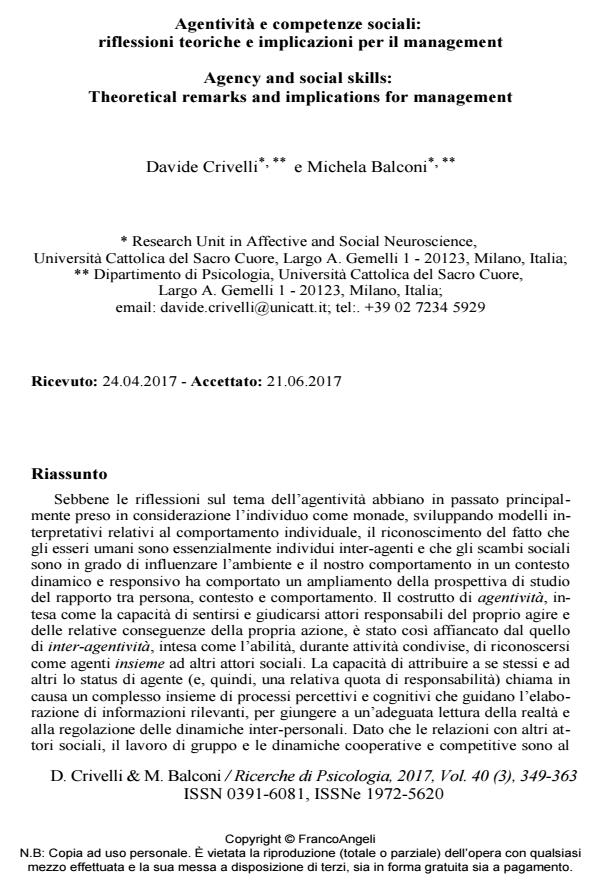Agency and social skills: Theoretical remarks and implications for management
Journal title RICERCHE DI PSICOLOGIA
Author/s Davide Crivelli, Michela Balconi
Publishing Year 2017 Issue 2017/3
Language Italian Pages 15 P. 349-363 File size 213 KB
DOI 10.3280/RIP2017-003006
DOI is like a bar code for intellectual property: to have more infomation
click here
Below, you can see the article first page
If you want to buy this article in PDF format, you can do it, following the instructions to buy download credits

FrancoAngeli is member of Publishers International Linking Association, Inc (PILA), a not-for-profit association which run the CrossRef service enabling links to and from online scholarly content.
Though traditional theories on agency primarily considered the individual as a monad and brought to the definition of interpretative models of individual behaviour, an increased focus on the intrinsic social nature of human beings and on the influence that social exchanges exert on shared environments and on our behaviour in a dynamic and responsive context broadened the investigation of the relations between person, context, and behaviour. The construct of agency, understood as the capability to sense and judge ourselves as causal agents responsible for our behaviours and relative consequences, has then been flanked by the construct of inter-agency, understood as the ability to recognise ourselves as agents together with other social agents during shared activities. The ability to attribute to ourselves and other subjects an agentive stance (and, consequently, even a relative amount of responsibility) grounds on a complex ensemble of cognitive and perceptual processes that guides, for example, processing of information to create a proper interpretation of the social context and to regulate interpersonal dynamics. Since relationships with other social agents, team-work, and cooperation-competition dynamics are at the core of business and management activities, the need for empowering the awareness of the way we read our own and others’ behaviour, of the way we and our inter-agents plan and regulate behaviour, and of the way we perceive ourselves as intentional agents within complex social systems is deemed as critical.
Keywords: Agency, inter-agency, social skills, social interaction, neuromanagement.
- Le forme di scambio tra le generazioni nei contesti organizzativi: la transizione dei neolaureati al mondo del lavoro Silvio Ripamonti, Andreina Bruno, Laura Galuppo, Cesare Kaneklin, in RICERCHE DI PSICOLOGIA 3/2021 pp.1
DOI: 10.3280/rip2021oa12858 - The Use of Hyperscanning to Investigate the Role of Social, Affective, and Informative Gestures in Non-Verbal Communication. Electrophysiological (EEG) and Inter-Brain Connectivity Evidence Michela Balconi, Giulia Fronda, in Brain Sciences /2020 pp.29
DOI: 10.3390/brainsci10010029 - Affective, Social, and Informative Gestures Reproduction in Human Interaction: Hyperscanning and Brain Connectivity Michela Balconi, Giulia Fronda, Angela Bartolo, in Journal of Motor Behavior /2021 pp.296
DOI: 10.1080/00222895.2020.1774490 - What happens to information, situational cues, and individual strategies in decision-making? The contribution of latent decisional profiles in realistic decisions Davide Crivelli, Carlotta Acconito, Michela Balconi, in DECISION /2024 pp.57
DOI: 10.1007/s40622-024-00374-3 - Stress and neurocognitive efficiency in managerial contexts Davide Crivelli, Giulia Fronda, Irene Venturella, Michela Balconi, in International Journal of Workplace Health Management /2019 pp.42
DOI: 10.1108/IJWHM-07-2018-0095 - The “gift effect” on functional brain connectivity. Inter-brain synchronization when prosocial behavior is in action Michela Balconi, Giulia Fronda, in Scientific Reports 5394/2020
DOI: 10.1038/s41598-020-62421-0 - Physiology of Risk-Taking and Risk Management in Realistic Decision-Making Scenarios Davide Crivelli, Roberta A. Allegretta, Michela Balconi, in Psychological Reports 00332941241258919/2024
DOI: 10.1177/00332941241258919 - Neuro-Empowerment of Executive Functions in the Workplace: The Reason Why Michela Balconi, Laura Angioletti, Davide Crivelli, in Frontiers in Psychology 1519/2020
DOI: 10.3389/fpsyg.2020.01519
Davide Crivelli, Michela Balconi, Agentività e competenze sociali: riflessioni teoriche e implicazioni per il management in "RICERCHE DI PSICOLOGIA " 3/2017, pp 349-363, DOI: 10.3280/RIP2017-003006